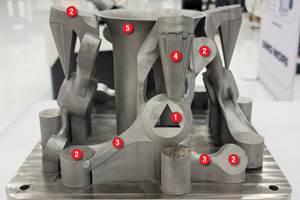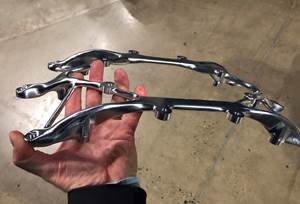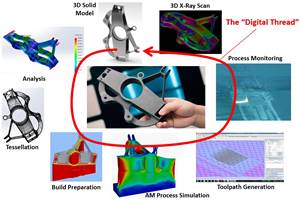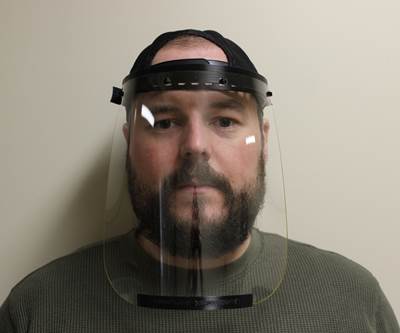Additive Manufacturing Versus COVID-19: The Race for PPE
Reporting from the front lines of the fight against coronavirus — still deep in the trenches.
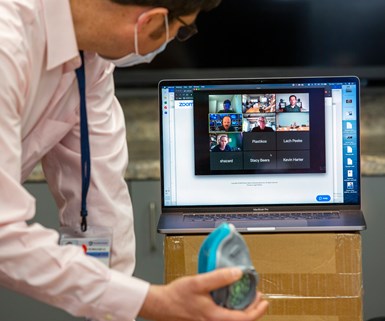
Design reviews and feedback sessions with the faculty, students, doctors, scientists, and industry partners were conducted remotely to practice good social distancing (Image credit: Penn State College of Medicine).
It’s hard to believe that it has been about two months since our lives were turned upside down by the coronavirus. As I wrote in my last column, the move to online classes at Penn State combined with seeing and sharing stories about 3D printed personal protective equipment (PPE) with my network of colleagues, companies and healthcare workers at Penn State’s Milton S. Hershey Medical Center (PSHMC) landed me right smack in the middle of the fight against COVID-19.
Before I knew it, our informal “grass roots” efforts to help 3D print PPE connected with the university’s senior leadership push to ready the team at PSHMC for the impending surge in COVID-19 cases. I was asked to lead the effort. We named it the Manufacturing and Sterilization for COVID-19 (MASC) Initiative. This limited our work to meeting the manufacturing and sterilization needs required to protect healthcare workers against COVID-19. Patient screening, vaccine development, antibody testing, and so on were thus out of scope for us.
Like many similar efforts springing up at universities and community maker spaces around the country, our first victory was the 3D printed face shields. We used the Prusa face shield design developed and open sourced by the team in Czechoslovakia. We redesigned it and optimized the processing parameters to reduce the build time by 60%, getting it well under one hour. Still, if you want to make 1,000 (or more) face shields per day, you need at least 50 3D printers running all out with minimal build failures and plenty of material on hand. As such, 3D printing is a good stopgap when there is a shortage of manufacturing capacity; but faster production methods were still needed to meet the looming demand.
The 3D printed headband was only one part of the shield, and we reached out in our network to find available laser cutters and polycarbonate sheet to make the rest of the face shield design. We found that laser cutters were in short supply in our area, and polycarbonate sheet was soon sold out around the country; so, we pivoted to the three-hole-punched version like everyone else and used transparency sheets to make the face shield. Unfortunately, as you can imagine, a face shield with a three-hole-punched transparency sheet will not meet FDA regulations, and it certainly does not pass the ANSI drop-test requirements for protective eyewear (ANSI Z871.1).

Dozens of filtration mask designs and material options were quickly prototyped, evaluated and revised thanks to 3D printing (Image credit: Matt Briddell, Penn State Center for Medical Innovation).
Luckily, the rapidly expanding network of our MASC Initiative included several companies that were able to change their manufacturing lines or set up entirely new lines to produce face shields, in volume, to meet the growing demands at PSHMC and other local hospitals. For instance, the team at Actuated Medical Inc. stood up an entirely new production line in their GMP-compliant facility in less than seven days to make reusable face shields that were compliant with relevant ANSI standards using more traditional manufacturing methods. Meanwhile, Universal Protective Packaging Inc. near PSHMC transformed one of its production lines to start cranking out several thousand face shields per day using more traditional manufacturing and assembly methods. Both companies are now supplying healthcare workers regionally while also meeting the rising demands from nursing homes, public works crews, police services and individuals.
While one of our teams was solving the face shield problem, another team was using 3D printing to prototype and test all of the N95-like filtration masks that were being shared online and open sourced. Based on feedback from doctors and clinicians at PSHMC, mask designs were quickly modified and revised to improve fit, comfort and breathability, and new prototypes were fabricated overnight and tested the next day.
This rapid design iteration and feedback cycle is where 3D printing really excels, and it became even more critical as shortages in supplies emerged — something we did not appreciate at first, but something that drove many of our design decisions. For instance, filtration material could no longer be sourced in the United States, and alternative supplies of filtration media were quickly exhausted from the shelves of hardware stores. This meant designing a smaller opening in the mask to use less filtration material for the limited supply we had, but this reduced the effective surface area, which reduced the filtering capability of the mask.
A test was developed to evaluate the filtration capabilities of different types and amounts of filtration material, and the mask team determined that adding three or four more layers would satisfy the requirements for N95 masks (although we have not been able to certify this given the backlog at NIOSH testing labs right now). Unfortunately, adding that much material made it too hard to breathe through the mask, and so, we went back to the drawing board.
As of this writing, we have solved the filtration problem with some creativity and old-fashioned engineering, including a bit of advice from a fluid dynamics expert we pulled onto the team, and it looks like we may have found a viable solution that can be mass produced. This was accomplished by engaging an industry partner specializing in tooling and injection molding on the team. They have provided invaluable advice as we modified designs and started to think about scaling up production. As you might guess, 3D printing can make nearly any geometry that is injection molded, but the reverse is not true. Complex features that are easily 3D printed will likely lead to exorbitant tooling costs for injection molding — but more on that next month.
Related Content
The Benefits of Vertically Integrating Metal 3D Printing and Machining
Having 3D printing and machining within one organization enables Addman’s engineers to collaborate and consolidate so it can quickly make successful metal 3D printed parts.
Read MoreDesigning a 3D Printed Part with Machining in Mind
Designing extra stock and mounting features into a 3D printed part can aid in machining processes downstream.
Read MoreUsing Topology Optimization to Lightweight: A Paradox for Machining
Today’s computer software can just as easily generate lightweight shapes for subtractive processes as it can for additive ones, but it increases cost and waste to make them.
Read MoreGo Digital: How to Succeed in the Fourth Industrial Revolution With Additive Manufacturing
The digitalization of manufacturing is set to transform production and global supply chains as we know them, and additive manufacturing has been leading the way in many industries.
Read MoreRead Next
Additive Manufacturing in the Age of COVID-19
Reporting from the front lines of the fight against Coronavirus — how my journey began.
Read MoreThe Cut Scene: The Finer Details of Large-Format Machining
Small details and features can have an outsized impact on large parts, such as Barbco’s collapsible utility drill head.
Read More3 Mistakes That Cause CNC Programs to Fail
Despite enhancements to manufacturing technology, there are still issues today that can cause programs to fail. These failures can cause lost time, scrapped parts, damaged machines and even injured operators.
Read More

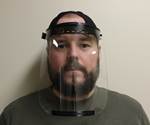











.png;maxWidth=300;quality=90)



.png;maxWidth=300;quality=90)



.png;maxWidth=300;quality=90)


